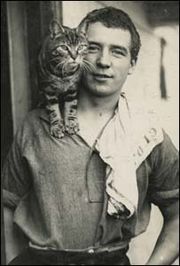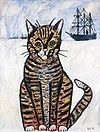
Mrs. Chippy
Encyclopedia

Cat
The cat , also known as the domestic cat or housecat to distinguish it from other felids and felines, is a small, usually furry, domesticated, carnivorous mammal that is valued by humans for its companionship and for its ability to hunt vermin and household pests...
who accompanied Sir Ernest Shackleton
Ernest Shackleton
Sir Ernest Henry Shackleton, CVO, OBE was a notable explorer from County Kildare, Ireland, who was one of the principal figures of the period known as the Heroic Age of Antarctic Exploration...
's Imperial Trans-Antarctic Expedition
Imperial Trans-Antarctic Expedition
The Imperial Trans-Antarctic Expedition , also known as the Endurance Expedition, is considered the last major expedition of the Heroic Age of Antarctic Exploration. Conceived by Sir Ernest Shackleton, the expedition was an attempt to make the first land crossing of the Antarctic continent...
of 1914–17, and—along with some of the sled dogs—was eventually shot after the expedition's ship, the Endurance
Endurance (1912 ship)
The Endurance was the three-masted barquentine in which Sir Ernest Shackleton sailed for the Antarctic on the 1914 Imperial Trans-Antarctic Expedition...
, was destroyed when it became trapped in pack ice.
Life
Mrs. Chippy, a tiger-striped tabbyTabby cat
A tabby is any cat that has a distinctive coat that features stripes, dots, lines or swirling patterns, usually together with an "M" mark on its forehead. Tabbies are sometimes erroneously assumed to be a cat breed. In fact, the tabby pattern is found in many breeds of cat, as well as among the...
, was taken on board the Endurance by Harry McNish
Harry McNish
Harry McNish was the carpenter on Sir Ernest Shackleton's Imperial Trans-Antarctic Expedition of 1914–1917...
, the carpenter nicknamed "Chippy" (as in chips of wood, chips or chippy being a standard British nickname for a carpenter or for a man named Carpenter), as a ship's cat
Ship's cat
The ship's cat has been a common sight on many trading, exploration, and naval ships, and is a phenomenon that goes back to ancient times. Cats have been carried on ships for a number of reasons, the most important being to catch mice and rats. These rodents, when aboard, could cause considerable...
. One month after the ship set sail for Antarctica it was discovered that, despite her name, Mrs. Chippy was actually a male, but by that time the name had stuck. He was described as "full of character" by members of the expedition and impressed the crew by his ability to walk along the ship's inch-wide rail
Guard rail
Guard rail or guardrail, sometimes referred to as guide rail or railing, is a system designed to keep people or vehicles from straying into dangerous or off-limits areas...
s in even the roughest seas. After the ship was destroyed, Shackleton decided that Mrs. Chippy and five of the dogs would not survive, and on 29 October 1915 recorded:
McNish had become particularly attached to the cat, and never forgave Shackleton for having him shot. He clashed with Shackleton during the expedition and, despite eventually constructing the boats that would take the party to safety, and displaying considerable fortitude and bravery, he was denied the Polar Medal
Polar Medal
The Polar Medal is a medal awarded by the Sovereign of the United Kingdom. It was instituted in 1857 as the Arctic Medal and renamed the Polar Medal in 1904.-History:...
awarded to most of the rest of the crew, on the grounds of his earlier insubordination. In 2004 a life-size bronze statue of Mrs. Chippy was placed on the grave of McNish by the New Zealand Antarctic Society in recognition of his efforts on the expedition.
Cultural references

Wolf Howard
Wolf Howard is an English artist, poet and filmmaker living in Chatham, Kent and was a founder member of the Stuckists art group...
, shows the cat "about to be shot", while in the background the crew launch a small open boat on a rescue mission and Endurance is stuck in the ice. The painting was shown in The Stuckists Punk Victorian
The Stuckists Punk Victorian
The Stuckists Punk Victorian was the first national gallery exhibition of Stuckist art. It was held at the Walker Art Gallery and Lady Lever Art Gallery in Liverpool from 18 September 2004 to 20 February 2005, and was part of the 2004 Liverpool Biennial....
at the Walker Art Gallery
Walker Art Gallery
The Walker Art Gallery is an art gallery in Liverpool, which houses one of the largest art collections in England, outside of London. It is part of the National Museums Liverpool group, and is promoted as "the National Gallery of the North" because it is not a local or regional gallery but is part...
during the 2004 Liverpool Biennial
Liverpool Biennial
Liverpool Biennial is a British international festival of contemporary art held in Liverpool. The festival comprises the International Exhibition, the John Moores Painting Prize, the Bloomberg New Contemporaries Exhibition and the Independents Biennial....
.

